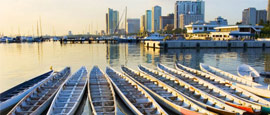Located around Binondo District, Manila’s Chinatown is a mazy district packed with the city’s Tsinoy heritage and cuisine. The Spanish colonial Governor first donated Binondo’s land to a growing influx of Chinese migrants in 1594. Besides hundreds of crowded food stands and fresh wet markets, the blackened Santa Cruz Church dates back to 1608. Key streets include Ongpin and Escolta.
Things to see in Manila
Tourist offices
Address: The New DOT Building, 351 Senator Gil Puyat Ave, Makati City, Manila, Philippines
Tel: +63 2 459 5200.
Opening Hours:Mon-Fri 0700-1800, Sat-Sun 0830-1730. www.tourism.gov.ph
Ayala Museum is known for its dioramas (3D miniatures) depicting vital points in Philippine history. The most magnificent exhibition is Gold of Ancestors – a glittering assemblage of golden pre-colonial artefacts and treasures, particularly intricately engraved jewellery fashioned by indigenous island tribes. Elsewhere, Embroidered Multiples displays 18th to 19th-century Philippine costumes.
One of the oldest and most dramatic colonial buildings in the Philippines, Fort Santiago was built to guard the entrance to the Pasig River around 1571. Its most famous prisoner was the national hero, José Rizal, who spent his last days at this site before his execution by the Spanish in 1896. Perhaps the height of architectural grandeur is the 1589 gate decorated by motifs of St James, the Slayer of Moors. The Japanese used Fort Santiago as their final redoubt against American forces and the fort was correspondingly damaged.
This lovely old walled colonial quarter was founded in 1571 by the Spanish on the Pasig River’s southern bank. It survived 400 years before being devastated by the battle for Manila between the Japanese and Americans in 1945, in which over 100,000 locals died. Faithfully restored after the war, it possesses atmospheric streets of plazas, churches and monasteries. Tours by kalesa (horse-drawn carriages) are easy to arrange.
In close proximity, these two monolithic museums can comfortably be seen together. The National Museum of the Philippines feels a little empty given its size but it hosts important artistic works by Filipino masters such as 19th-century painter Juan Luna. Meanwhile, the star turn of the National Museum of the Filipino People’s historical and anthropological exhibits is the preserved wreckage and treasures of the San Diego, a Spanish galleon sunk in Philippine waters in 1600.
This superb aquarium is the must-see attraction of the new Manila Ocean Park’s mall. Visitors are taken on a journey through a range of fishy habitats from freshwater tanks to oceanic exhibits featuring rays, sharks and iridescent reef fish. Don’t miss the 25m (82ft) underwater tunnel or the illuminated exhibition of ‘dancing’ jellyfish.
Stunning baroque church dating from 1587 making this one of the oldest in the Philippines. It miraculously survived the wartime devastation and is now the standout highlight of Intramuros in Manila. Trompe l’oeil murals decorate its interior and a small museum in an attached monastery contains some exquisite ecclesiastical artefacts such as altarpieces and screens. Don’t miss Father Blanco’s garden.
You don’t have to be a shopaholic to be wowed by this mega-mall, which embodies the rise of indoors retail therapy in the Philippines. SM Mall of Asia is the country’s fourth largest, and leaves visitors wide-eyed by its immensity and pizzazz. Besides myriad retail and food outlets, it boasts an IMAX theatre, an Olympian ice-skating rink, ten-pin bowling and even a science museum. A sunny terrace overlooks the Bay of Manila.
Founded in the 1850s, Manila’s Chinese Cemetery was designated as the resting place for Chinese citizens denied burial in Catholic cemeteries. The cemetery has an array of ostentatious tombs including some outfitted with air conditioning, flushing toilets, chandeliers and modern conveniences for the well-off corpses. Guards will offer impromptu tours to the pick of the tombs for a small consideration. On All Saints Day (1 November), lavish feasts honouring the dead take place here.
Known locally as ‘Luneta’, this 58-hectare (143-acre) park remains downtown Manila’s green lungs. The park is named after José Rizal who is remembered by an imposing obelisk-style memorial. The park hosts several themed gardens, a planetarium and an orchidarium (with a butterfly pavilion). Above all, Rizal Park is somewhere to picnic, people-watch, practice tai chi, or jog. The open-air auditorium hosts occasional free public concerts.
Do you have any Feedback about this page?
© 2026 Columbus Travel Media Ltd. All rights reserved. No part of this site may be reproduced without our written permission, click here for information on Columbus Content Solutions.








 You know where
You know where